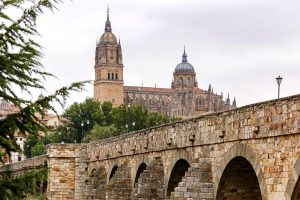SALAMANCA
The Congress will be celebrated in the city of Salamanca (Spain).
Where is Salamanca?
Salamanca is a municipality and Spanish city, capital of the province of the same name, located in the autonomous community of Castilla y León. It is located in the region of Campo de Salamanca, in the North Plateau, in the northwest quadrant of the Iberian Peninsula.
How many people live in Salamanca?
It has a population of 144 436 registered inhabitants (INE, 2017). Its stable functional area reaches 203 999 citizens, which makes it the third most populated in the community, after Valladolid and León.
What is there to visit?
Salamanca is home to the oldest active university in Spain, the University of Salamanca, founded in 1218 by Alfonso IX of Leon on the germ of its general study, and which was the first in Europe to hold the title of university by royal decree of Alfonso X the Wise dated November 9, 1252 and by the licentia ubique docendi of Pope Alexander IV in 1255. During the time when it was one of the most prestigious universities in the West, the phrase “Quod natura non dat, Salmantica non præstat”, ‘What nature does not give, Salamanca does not lend’, became popular. Salamanca is linked to universal history by names such as Antonio de Nebrija, Christopher Columbus, Fernando de Rojas, Francisco de Vitoria and the School of Salamanca, Fray Luis de León, Beatriz Galindo or Miguel de Unamuno.
In 1988, the old city was declared a World Heritage Site by UNESCO. It has an important historical and architectural heritage, including its two cathedrals -the Old and the New-, the Casa de las Conchas, the Plaza Mayor, the convent of San Esteban and the Escuelas Mayores. In 2002, it was named, together with the Belgian city of Bruges, European Capital of Culture by the Council of the European Union and the European Parliament.
More information: https://salamanca.es/es/
This page is based on Wikipedia info.





